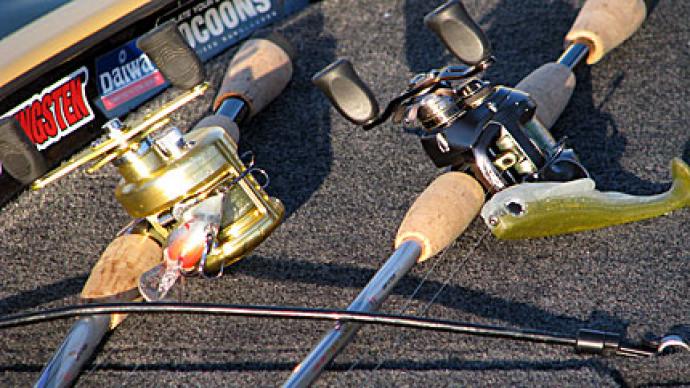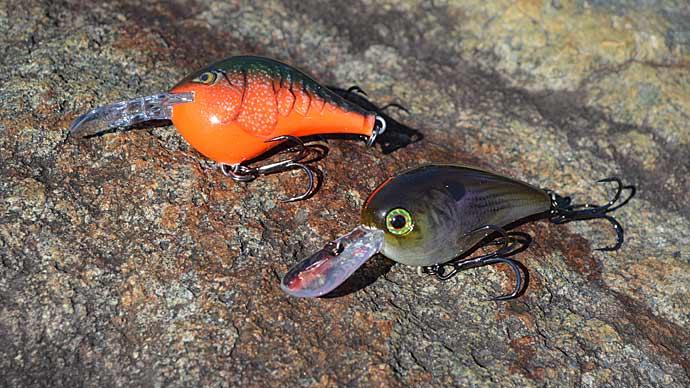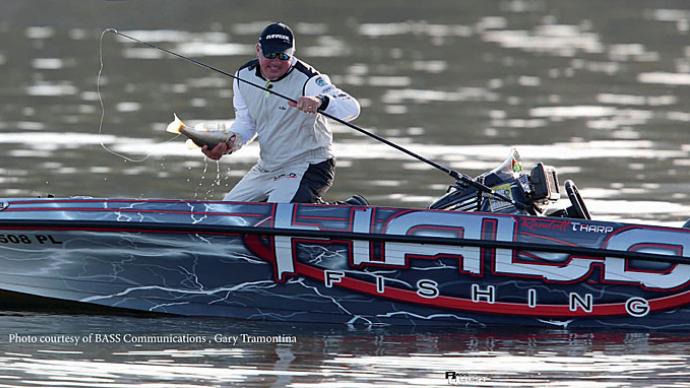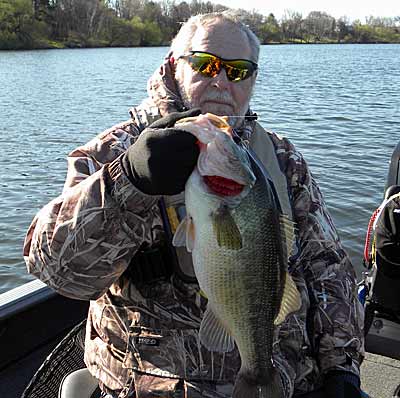
Early season bass can be challenging at times. You back the boat down the boat ramp expecting a certain water temp, only to find out once you idle away from the landing that the water is 4 to 6 degrees cooler than you expected. You're now faced with a few decisions right at the start of your fishing day.
New lake, you have water temps in the upper 40's-48 degrees to be exact, so where will the bass be? This can be a total roll of the dice, but there are a few things that you should be looking for.
I always like to start by looking for warmer water early in the season. Take a little time to get the lay of the lake, look at different bays, and especially pay attention to the water temps in these areas. I'll print a lake map before my travels, and once I get to the water, I'll pull out that map and go for a quick ride. If this is a bigger lake, I'll break down the water into sections and take a section at a time. I'll quickly drive around to get temp readings in a smaller lake.
Head into each bay area, pay attention to cover and especially check the water temperature as you take a closer look at the map on your unit. Look for areas that head out of deeper water towards the shallows. This is the path the bass will get from deeper water holding areas up to the feeding and spawning areas.
The main point, though, is the water temperature in this lake. Take a pen and mark the temperature on your paper map. Once you have made your tour around the lake, take a closer look at your map. Where is the warmest water located? This will be the start of putting the pieces of the puzzle together. This is how I start to break down waters during the early season that I have not been on before or at the start of a new season if I have been on these waters recently.
Rule of thumb, the North end of the lake may have some of the warmest water early in the season as these bays are somewhat protected from the colder North winds. North winds will blow the colder water towards the South end of the lake. Unless there is a South bay, the entrance is somewhat blocked from a direct North wind.
Start in the warmest water and work your way backward. This will put you close to the most active bass in this body of water. As you figure out patterns, you should catch fish as you travel area to area.
Crankbaits Choices
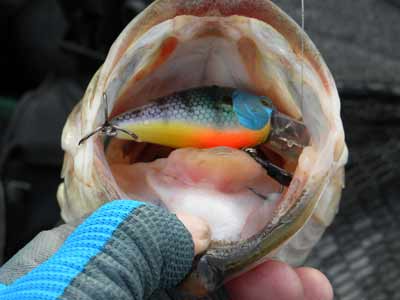
Now that you have picked a few sections, go back to these places and look for bass signs. One of the first things that I'll do is grab a 3/8oz spinnerbait or vibrating jig and take a quick tour through the shallows to see if there are any signs of bass. Did you get a bite on the spinnerbait or a vibrating jig? If the answer is yes, then make your next pass with a square bill tied on. Do you have the same results?
I say switch to a square bill crankbait because I can slow my retrieve down and keep my bait in the bass zone longer. I really can't do that with a spinnerbait or vibrating jig. If I slow my retrieve down, my bait will get deeper in the water or get buried into the cover.
When fishing a crankbait, I get more control over how fast my bait goes and how deep it can reach. When the bass gets locked into a depth range in the springtime, I'll have better depth and speed control with a crankbait than I do with many of the other baits in my tackle box.
Early in the season, you'll need to cover your bases and bring a broader range of crankbaits to reach the depth you may have to fish. For example: if you made that first pass with no bites, I would move out to that 5ft to 10ft range. If I made a pass through this area with no takers, I would take another step back. This has told me I don't think I have any bass up waiting for the shallows to warm up to make that first spawning push. Chances are these bass are still sitting in deeper water, waiting for a warming trend to push the water temps up.
I'll take a step back at this time also and take a look at my Lakemaster chip in my Humminbird unit to see where there is deeper water that leads to the shallower areas in the bay. First, look for long points that extend out to deeper water. These will be the first logical place to check. Also, look for minor points out in 12 to 15ft of water to give you a path to the flats.
I can do this in two ways. One of the quickest ways to get a closer look is to grab a crankbait that runs 10ft to 12ft and make a quick pass through this area. Keep your eye on your electronics when you're doing this. Do you see any signs of fish in the area? Then start to use a stop-and-go retrieve over these bass. Stop your bait in the bass zone and see if you can trigger a strike from the bass that you see on your electronics.
If you still see fish on the bottom that won't come up to get a crankbait, it may be time to make a change.
Put your crankbait down and grab a jig. Get a bait in front of the bass at their level. If you see bass on the bottom that will take a jig, go with the opportunity to see if you can trigger the bass to bite. This will tell me two things if I can get the bass to bite a jig that day, use it. It may be just a bit too early for a crankbait, but I bet you can come back in a day or two and start to trigger those same bass to bite a crankbait if the water warms up a few more degrees.
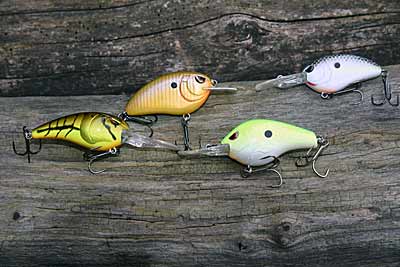
A few days later, start over again and hit the same area with a crankbait if the water temps have climbed a little. Chances are, it's crankbait time, but if the water temps are the same, you may be faced with the same scenario. But check and find out. You won't know until you try.
Let's say you make a pass with your crankbait, and you trigger a few bites using a SPRO Rock Crawler 55. Then work the area and trigger as many bites as you can. Next, pick up the jig and see if you can trigger a few more bites from less active bass in the area. As the water warms up, the bass will continue to move shallower, so keep adjusting your crankbait as you move.
Your next move will be to a shallower running crank. The SPRO Little John will fill this bill perfectly. Also, throw a Fat Papa in the mix. These two different crankbaits have different shapes and running patterns that complement each other perfectly, so make sure you're armed and ready to go.
As the bass move, shallower weeds will start to play a significant factor, so you'll want to make contact with the cover with your crankbait as this will help trigger more strikes.
Sound vs. Silent Crankbaits
This is a question that many crankbait fishermen don't understand. You're best to stock and carry both rattle and silent crankbaits in your box as you'll need both. Rule of thumb when fishing in clear water conditions, grab a silent bait, but when fishing in stained and dirty water conditions, use a crankbait with rattles. This will help the bass find your bait when they can't see very far.
At times I'll go against the rules if I'm fishing in clear water conditions and the bass are buried in cover. I will go with a crankbait with rattles to help get the bass out of the weeds. The best way to work this scenario is to use a crankbait to tick the top of the weeds or cover with and sometimes get fouled. When the bait gets hung up, give it a good jerk (just like you're setting the hook) to get it free back on its way again. This can trigger bites from bass in the cover. Use this tactic to your advantage.
Crankbait Equipment
Crankbait fishing, like all fishing, will require specific equipment suited for this technique. I will generally fish two different lengths and actions for rods. I'll use a 7-foot Denali Attax (AC7002GC) medium-action crankbait rod to go down the shore target castingDenali Attax (AC7002GC) medium-action crankbait rod. I team this with a Lew's BB-1 baitcaster (5.4:1 gear ratio) spooled with 10lb -12lb Sunline Crank FC line. In this case, I picked a shorter rod to hit the shore targets accurately.
I will opt for a longer crankbait rod for added casting distance and hook setting power if I'm fishing offshore. I will fish a Denali Attax (AC7043GC) rod. Again, I'll team this with a Lew's BB-1 (5.4:1 gear ratio) reel spooled with 12lb-14lb Sunline Crank FC. I often throw bigger crankbaits with this setup, so I up the line size to 12–14lb test.
When fishing crankbaits, you have more control of the speed you can fish the bait and keep it in the strike zone longer to trigger more bites. You can also add sound, so keep both crankbaits stocked in your box. I hope this gives you a different bait to use this Spring and all season long. Crankbaits can put bass in your boat through the seasons if you give them a chance.


